Sixteen years ago, Aiyen Tjoa was exploring a small mining town of Sorowako in the heart of the Indonesian island of Sulawesi. Sorowako once had been a home to immense diversity of plants, and most of them were found nowhere else. But then the small town became the hub of one of the largest nickel mining areas in the world, with one company alone extracting 5% of the global nickel supply.
When Tjoa, a soil biologist and lecturer in Tadulako University in Central Sulawesi, arrived in Sorowako in 2004, most of the lush vegetation had already been cleared for mining, leaving barren soil and dusty roads in its place.
But some bushes and young trees survived. Back then, Tjoa was eager to find those rare plants that were adapting well to their new, nickel-rich surroundings. These, she reasoned, could be “super plants” capable of taking up high levels of nickel from the soil and storing it in surprisingly high quantities. As well as cleaning the soil, these nickel-rich plants could be “mined” to provide an alternative source of the metal, allowing nickel to be harvested without destroying the ecosystem.
You might also like:
- The otter rescue plan that worked too well
- The ingenious ‘solar canals’ of India
- The folklore saving animals’ lives in the Philippines
The plants Tjoa was looking for are known as nickel hyper-accumulators – a group of rare plants able to concentrate at least 1,000 micrograms of nickel per 1g of dried leaf.
Most plants draw up tiny amounts of heavy metals to activate some important enzymes, and nickel is needed to activate one crucial to plants’ flowering process. But even slightly too much nickel can poison and kill most plants. Nickel hyper-accumulators, however, have evolved the ability to withstand this excess by binding the metal inside their cell walls or storing it in their vacuoles – a storage organelle inside the cell, says Tjoa. They mainly store the nickel in their shoots, leaves, roots or sap.
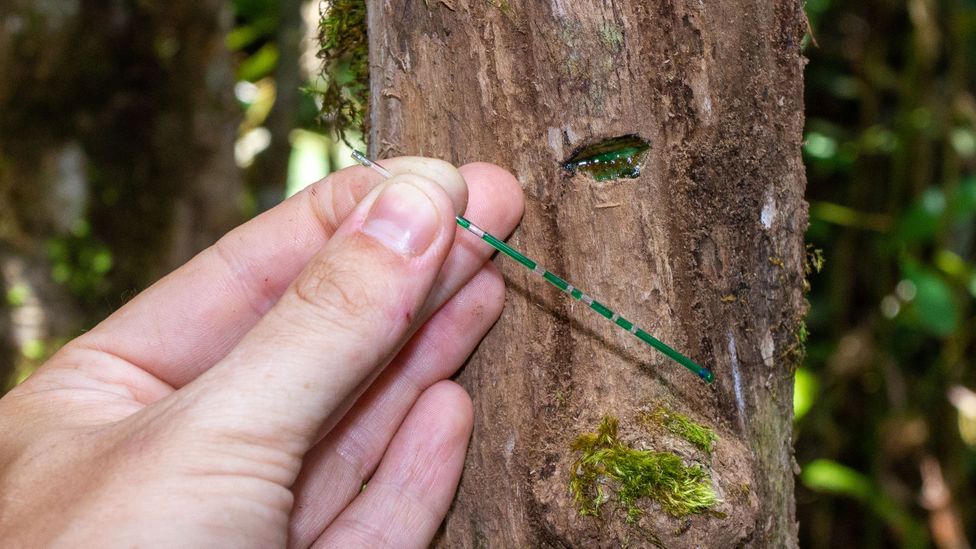
Some nickel hyper-accumulators hold so much of the metal in their sap that it turns a bright green or blue colour (Credit: Antony van der Ent)
Some nickel-loving species like Alyssum murale, native to Italy, can take up to 30,000 micrograms of nickel per 1g dried leaf. Some, like Phyllantus balgoyii, found in Malaysia, have such a high nickel content that their sap is a remarkable bright blue-green colour. So far, around 450 species of nickel-loving plants have been documented worldwide. Most of these plants grow in countries with less plant diversity and lower nickel deposits than Indonesia, such as Cuba (130 species), southern Europe (45), New Caledonia (65) and Malaysia (24).
Curiously, very few of these plants have been found in Indonesia, which is one of the most biodiverse regions in the world and also has the largest nickel deposit in the world – just where you might expect to find a nickel hyper-accumulator. Tjoa says that this is largely because very few people have spent the time looking.
The long search
When Tjoa secured a permit from the mining company that holds the concessions in Sorowako, she quickly packed up her gear to scan the area. She had to fund her own explorations, and for four years she came back to Sorowako time and again to look, without success. The work was painstaking and, at first, disappointing.
Part of the reason her search was slow was that to the naked eye, such plants look rather ordinary. But, when a likely suspect is found, there is a simple on-the-spot test to identify whether it is a hyper-accumulator or not. Antony van der Ent, a plant ecophysiologist from the University of Queensland who studies nickel hyper-accumulators, describes using a white circle of detection paper to test for nickel. “The paper instantly turns pink when leaves are pressed against it. It’s foolproof, easy to do and fast,” he says.
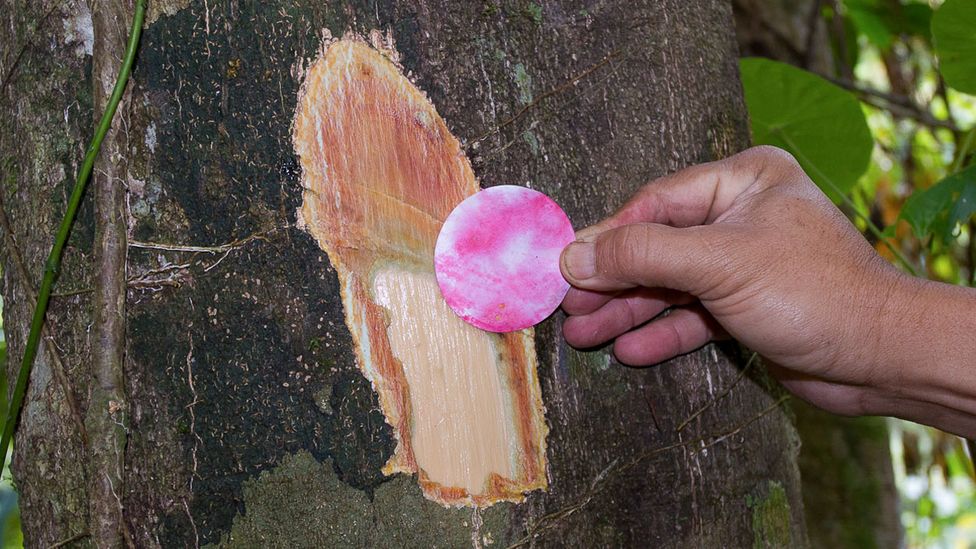
A quick in-situ test is to use detector paper that turns pink on the spot (Credit: Antony van der Ent)
But just because nickel is present doesn’t mean the plant is a hyper-accumulator. To analyse how high the nickel concentration is, a sample is brought back to the lab, dried and examined using X-rays. A hand-held device shoots an X-ray beam at the sample, which reacts by emitting a specific amount of energy that is characteristic of nickel atoms.
After four years of exploration, Tjoa at last spotted two species of indigenous nickel hyper-accumulators in 2008: Sarcotheca celebica and Knema matanensis. In the lab, she found that both of these native plants could store between 1,000 and 5,000 micrograms of nickel per gram of dried leaf.
It was a start, but Tjoa was still hoping for something more. Compared with nickel-loving plants found elsewhere, these two showed fairly modest powers of hyperaccumulation. “We’re looking for plants that could accumulate at least 10,000 micrograms [per gram],” she says. At that threshold, it becomes economically viable to cultivate the plant for mineral extraction – or “phytomining”.
Tjoa’s research on these plants drew the attention of Satria Bijaksana, a professor of rock magnetism from Bandung Institute of Technology. Bijaksana was looking for relevant research on the relationship between Sulawesi’s geology and ecology, when he became fascinated by the phytomining studies conducted by Tjoa and by van der Ent. He wondered if his own expertise in magnetism could help speed up the search.
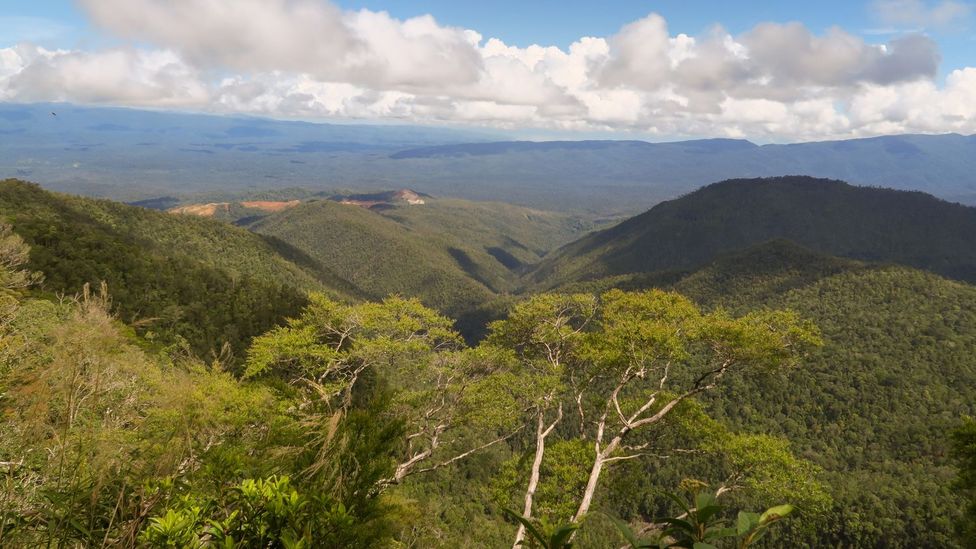
The forests of Indonesia are exactly where nickel hyper-accumulators would be expected to appear - in biodiverse, nickel-rich ground (Credit: Antony van der Ent)
As hyper-accumulators have very high quantities of metals, so do their ashes once they have been burned – and some of these metals are magnetic. A number of studies have shown that nickel uptake in hyper-accumulator plants happens at the same time with the uptake of iron – a highly magnetic metal. Together with Tjoa, Bijaksana designed an experiment to see if magnetic susceptibility increases when the plants accumulate more nickel. By comparing the ashes from two species of well-known hyper-accumulators (Alyssum murale and Alyssum corsicum) with 10 indigenous plants in Sulawesi and Halmahera, they found another positive result – one of the native plants was high in both iron and nickel.
“We think using magnetism could speed up the process because it only detects high concentrations of nickel,” says Bijaksana, leading to fewer false positives as a result. Their study, which was published in May 2020, identified two further species of nickel-loving plants from Sulawesi: Casearia halmaherensis and another that was a type of pepper. Both could accumulate 2,600-2,900 micrograms in 1g of dried leaf. While the research is still preliminary, Bijaksana hopes it could convince people to take phytomining seriously in Indonesia.
A new way to mine
The beauty of nickel hyper-accumulators is that they collect something that is both a toxic pollutant if left in the soil, and a valuable material – nickel is used in making products from kitchen taps to electric car batteries. Collecting the nickel from plants is a relatively easy process.
The University of Queensland’s van der Ent has calculated that a hyper-accumulator like Phyllantus balgoyii can produce an estimated 120kg of nickel per hectare every year. That translates to a market value of around $1,754 (£1,300) per hectare. Extracting the nickel involves pruning the shoots – which hold the highest concentrations of the metal – and burning them, after which the nickel can be separated from the ash. This involves releasing carbon dioxide through burning, but the continuous cultivation of nickel hyper-accumulators can be considered carbon neutral, says van der Ent. “All carbon released from the burning will be ‘captured’ again by the newly growing crop in a few months,” he says.
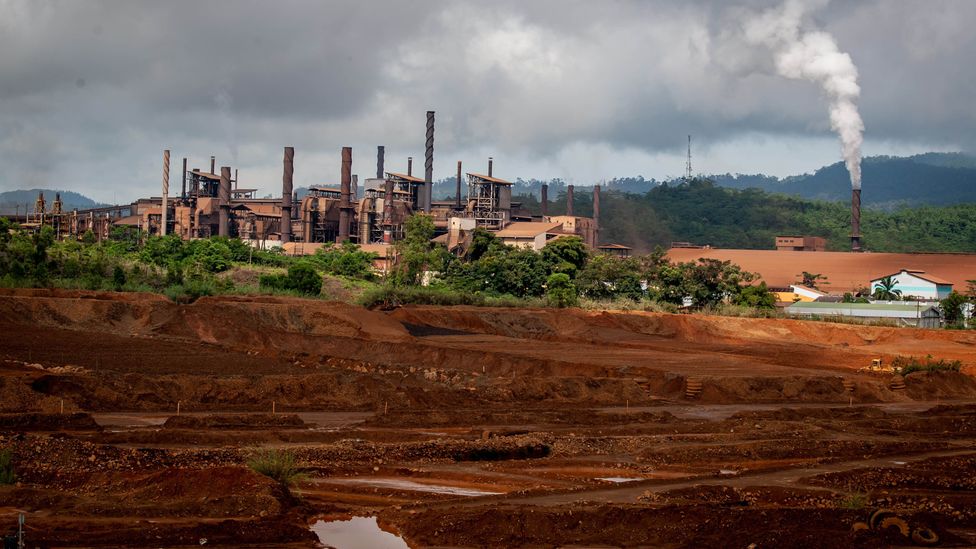
Traditional strip-mining requires clearing swathes of vegetation, and destroys large tracts of biodiverse Indonesian forest habitat (Credit: Getty Images)
Phytomining has considerable environmental advantages over traditional forms of mining. In Sorowako, nickel is extracted through open-pit mining, to access nickel embedded inside laterite rocks. To get the nickel, the rocks need to be crushed, which can release radioactive elements, naturally occurring asbestos-like substances, and metallic dust. Open-pit mining also produces waste materials in the form of a toxic semi-liquid waste known as tailings. If not properly managed, arsenic and mercury-laden tailings can leak into surrounding environment. More broadly, traditional mining as a whole is a considerable carbon emitter, releasing at least 10% of greenhouse emissions in 2017.
As well as offering a more environmentally friendly way to mine nickel, these plants could help to rehabilitate land that has already been mined. Tjoa says most mining companies in Indonesia ignore a requirement to replant disused sites with vegetation. When they do, they often try using ordinary plants, rather than nickel-loving species.
But that undiscerning revegetation process is flawed, says van der Ent. “Most of these plants are common weeds that are highly undesirable for rehabilitation,” he says. Nickel hyper-accumulators could do it better, he says, by improving soil health by removing the nickel and bringing back the major nutrients needed by normal plants. “Eventually, normal crop plants can be cultivated on these soils after phytomining has finished,” he says. It could also give an economic benefit for the mining company because the nickel residue that has been accumulated in their shoots could be harvested. Currently, only soil that consists of at least 1% nickel can be mined in the traditional way. “But a hyper-accumulator can achieve high levels of nickel accumulation in a soil that consists of just 0.1% [nickel],” he says.
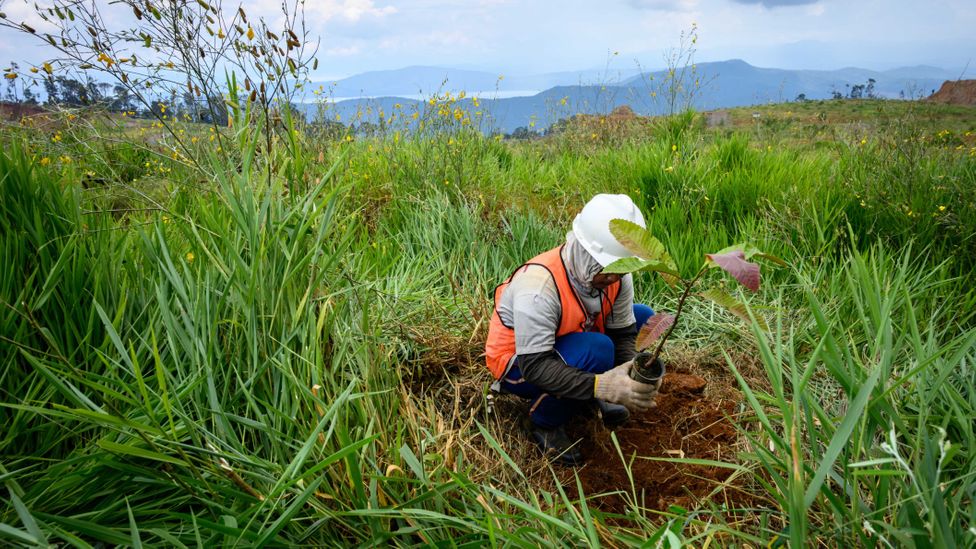
Often, efforts to restore vegetation after strip mining involves using plants that aren't nickel hyper-accumulators (Credit: Getty Images)
In Sabah, Malaysia, van der Ent has been conducting phytomining field trials since 2014. “We found out that phytomining really works,” he says. This could also be applied in soils that have not been mined but have naturally high levels of nickel. But van der Ent underlines that the technology is not aimed at replacing open-pit mining. That would be hard, given that Indonesia is the largest nickel producer in the world, with around 73 million tonnes of nickel exported last year. Instead, phytomining could be done in parallel. Most importantly, unlike traditional mining, which often clashes with indigenous communities, “we envisage that it will be implemented by smallholders in rural communities living on nickel-rich areas as an alternative form of agriculture”, says van der Ent.
Despite the potential, Tjoa has been frustrated at the slow pace of development of phytomining in Indonesia. “No one seems to pay attention to this potential,” she says. She says she tried to communicate with the mining firm PT Aneka Tambang (Antam) in 2009, Indonesia’s state-owned mining company, but the response was very slow and uncertain. The firm PT Inco once supported her research on phytomining when she did a field trial on the adaptation of Alyssum murale in Sorowako. But the collaboration was terminated partly because the company was restructuring. “Unfortunately, no collaboration since then,” she says.
The situation is an irony, says van der Ent. “No other country has a greater potential for phytomining than Indonesia,” he says. Given the extraordinary plant diversity and geological history, he is convinced that the country has a huge potential for the discovery of nickel hyper-accumulators. Sulawesi and Halmahera, the neighbouring island, has the largest ultramafic bedrocks, which can be rich in nickel, in the world, at 23,400 hectares (234 sq km/90 sq miles). As well as having high nickel concentrations, soils that originate from this bedrock support a high level of plant endemism. “That brings the minerals industry capitalising on nickel resources in direct conflict with biodiversity,” says van der Ent.
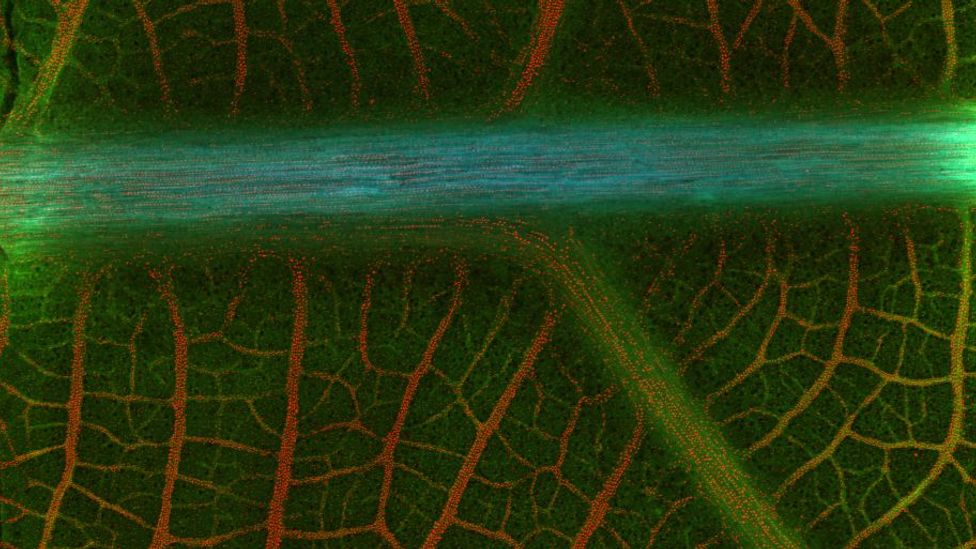
If the nickel within these rare plants could be tapped, it would provide a sustainable source of nickel for use in electric vehicle batteries (Credit: Antony van der Ent)
The researchers believe many potential hyper-accumulators could be vanishing in rapid land clearances before they can be discovered. Between 1990 and 2018, Sulawesi lost nearly 19% of its forest cover. “We have lost such a big chance to find these plants,” says Tjoa.
Shoots of hope
But Tjoa has not given up her search for hyper-accumulators. In central Sulawesi, a pristine rainforest sits on nickel-rich soils that make up the mountainous region in Morowali natural reserve. This greyish soil, which forms above a bedrock called serpentinite, is thought to be the perfect place for nickel-loving plants to grow. “Our survey in [the Indonesian island of] Halmahera has shown that nickel hyper-accumulators are common in this category of soil, but people haven’t looked for it in Sulawesi yet,” says van der Ent. “It all comes down to concerted efforts to find them.”
In the meantime, an overseas mining company has expressed interest to experiment with phytomining locally, says Tjoa. In 2017, she was contacted by US-based investor who intends to fund her 5,000-hectare (50sq km/19.3 sq mile) trial in Sulawesi. For this project, she says, she would like to use Alyssum murale, the nickel-hyperaccumulator plant from Italy. It might not be ideal to use foreign species in Sulawesi’s ecosystem, but it is at least a sure bet. “Maybe we have to use it first to convince Indonesian government that phytomining works,” she says.
Tjoa hopes that phytomining could become a part of every mining zone, with firms required to reserve a portion of rainforests in their concession area. Using plants rather than heavy machinery to mine would create less waste, preserve the ecosystem and produce less toxic waste. “That,” says Tjoa, “is extraordinary.”
--
The emissions from travel it took to report this story were 0kg CO2. The digital emissions from this story are an estimated 1.2g to 3.6g CO2 per page view. Find out more about how we calculated this figure here.
--
Join one million Future fans by liking us on Facebook, or follow us on Twitter or Instagram.
If you liked this story, sign up for the weekly bbc.com features newsletter, called “The Essential List”. A handpicked selection of stories from BBC Future, Culture, Worklife, and Travel, delivered to your inbox every Friday.
"that" - Google News
August 26, 2020 at 06:16AM
https://ift.tt/2EELWd9
The hidden plants that 'bleed' nickel - BBC News
"that" - Google News
https://ift.tt/3d8Dlvv

Tidak ada komentar:
Posting Komentar